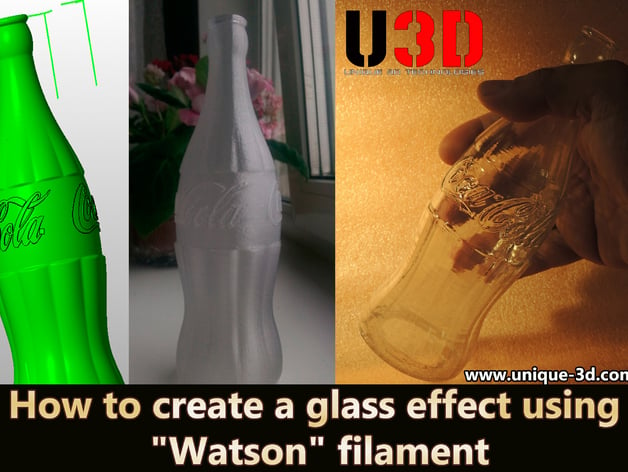
Coca Cola Bottle
thingiverse
Human: New plastic filament brand "Watson" has been introduced with a unique property - lowest coefficient of thermal expansion. This makes it ideal for large-size 3D printing layouts. The material is well-suited for printing big projects without any warping issues. For instance, you can easily print a violin as shown in the video at https://youtu.be/oknLLjHntjs. Another advantage of Watson filament is its ability to produce transparent products. You can make beautiful glass-like objects using this plastic. Watch this video to see how it's done: https://www.youtube.com/watch?v=6UDtterjIMM. To learn more about Watson filament, check out the manufacturer's website at http://unique3d.ru/en/. They offer a wide range of colors for this product. When printing with Watson, we highly recommend using Sitall Glass Plate. It provides excellent adhesion and allows for easy removal of the print after it cools down. The U3D Sitall Glass Bed is designed for heated bed platforms and features low thermal expansion. It's perfect for printing ABS and other plastics. Here are some settings you can use when printing with Watson: Printer: U3D Delta Infill: Vase To create a glass-like effect, follow these steps: Post-printing: Make sure the model is not hollow or has any voids. Printing Settings: Use a nozzle with a larger diameter (0.8 mm) and set the layer height to 1/3 of the nozzle diameter (0.26 mm). Infilling: Set the infilling parameter to "Vase" in KISSlicer or "Spiral vase" in Slic3r. Printing Speed: Keep the printing speed slow, around 40-20 mm/s. This will help achieve a high-quality finish. Wall Thickness: Ensure that the wall thickness is uniform throughout the product. If you set multiple perimeters, it may not be possible to permeate the solvent and achieve a glossy finish. Extrusion Multiplier: Increase the extrusion multiplier to around 1.2-1.4 in Slic3r's "Filament Settings". Temperature: Set the nozzle temperature between 190-270°C (varies by printer) and the heatbed at around 100°C (varies by printer). Heatbed Plate: The Watson Plastic sticks well to most heatbed plates, but we recommend using Sitall Glass Plate for best results. This glass plate is specifically designed for 3D printing and provides a tough, super-flat surface. Post-processing: To create the glass-like effect, you'll need: a) Solvent (diluted oily paints) b) D-Limonene c) A metal container or plastic resistant to aggressive environments d) Hair dryer Begin the process by pouring a small amount of solvent into a container and moistening the surface of the bottle. Then, dry the bottle with a hair dryer for 4-6 minutes. If you want to remove stains or fingerprints, repeat the process. However, be careful not to dissolve the plastic too quickly. That's it! If you have any questions, feel free to ask. Thanks for watching!
With this file you will be able to print Coca Cola Bottle with your 3D printer. Click on the button and save the file on your computer to work, edit or customize your design. You can also find more 3D designs for printers on Coca Cola Bottle.
